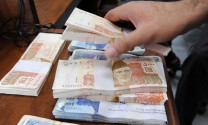Trade deficit shrinks on strong export growth
Country to focus on regional markets as demand from US and EU falls.

Pakistan’s trade deficit marginally narrowed last month on the back of an unexpectedly strong growth in exports which outpaced imports, but to keep the momentum going the country will bank on regional markets after experiencing weak demand in Europe and America.
The trade deficit – the gap between imports and exports – stood at $1.5 billion in July, which was $27 million or 1.8 per cent less than the corresponding period last year, reported the Federal Bureau of Statistics (FBS) on Thursday.
The deficit shrank after the country saw the highest level of exports for the month of July, which is usually considered a lean month for trade. Exports rose to $2.2 billion, which was $477 million or 27.7 per cent more than the exports made in July last year, said the FBS.
Imports totalled $3.7 billion, around $450 million or 13.9 per cent higher than imports in the corresponding period the previous year.
Independent trade experts fear that the healthy trend in exports may tamper off in the months ahead as cotton prices have fallen significantly in the international market. World stock markets have also plunged on fears of a double-dip recession. The downgrading of US credit rating for the first time and spread of European financial crisis have panicked the investors. All this may lead to weakening demand for Pakistani products.
Officials do agree with the independent assessments but have their own recipe to avoid the worsening global economic situation.
“The momentum will be maintained by shifting focus to regional markets and exploiting world demand for basic textiles,” said Tariq Puri, Chief Executive Officer of Trade Development Authority of Pakistan.
He said Pakistan will further liberalise trade with India and fresh initiatives in this regard will be announced in the upcoming trade policy. He said other than India, exporters would also further penetrate the markets of China, central Asian states, Japan and Russia.
He said the fall in world textile prices would be compensated by increasing the volume of exports. In addition to textile exports, the country is expected to earn at least $2.5 billion from rice exports this year.
In Annual Plan 2011-12, the government has estimated exports at $25.8 billion while import bill will swell to $38 billion. However, after having exports of $25.2 billion last year, the government may jack up the target by 10 per cent. A formal announcement will be made after getting endorsement of the trade policy from Prime Minister Yousaf Raza Gilani.
On monthly basis, the trade deficit widened 3.5 per cent in July as compared to June. Exports dipped 9.23 per cent while imports shrank 4.5 per cent. June is usually considered a peak month for trade.
Published in The Express Tribune, August 12th, 2011.



















COMMENTS
Comments are moderated and generally will be posted if they are on-topic and not abusive.
For more information, please see our Comments FAQ